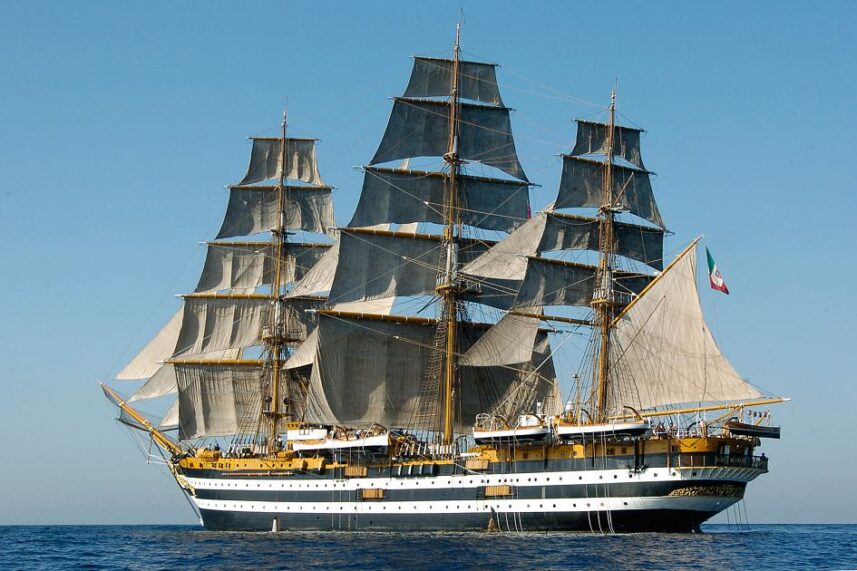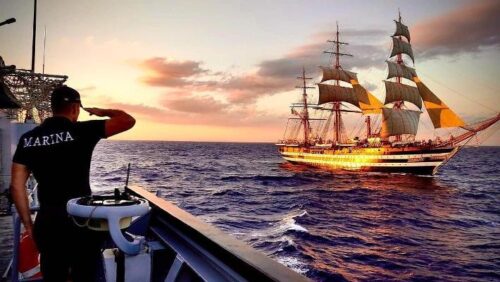Country system and Italian excellence on the move
"The Lady of the Seas, the most beautiful ship in the world, forge of officers of our Navy, set to sea today” says the Undersecretary of State for Defense Matteo Perego of Cremnago “20 months of world tour in 27 countries touching all the continents of the globe, bringing a piece of Italy to all the springs that will host it and to all seas".
"Fair winds to the crew of the national icon sailing ship” concluded Perego “good luck to the students who will become a course in this adventure and a thought for a soul who will be with you, that of Michele Savarese who left us a few days ago!"
DEEPENING

La Amerigo Vespucci School Ship, is the oldest Unit in service in the Navy entirely built and fitted out at the Royal Naval Shipyard of Castellamare di Stabia. Hull laid down 12 May 1930, she was launched 22 February 1931; godmother of the launch was Mrs. Elena Cerio. Delivered to the Regia Marina on 26 May 1931, she entered service as a training ship on 6 June, joining her sister ship Cristoforo Colombo (actually slightly smaller), three years older, and forming with her the "School Ships Division" at the command of Admiral Cavagnari. Upon returning from the first Education Campaign, on 15 October 1931 she received the Combat Flag in Genoa, offered by the local UNUCI Group (National Union of Discharged Officers of Italy).

The ship's motto is "Not who begins but what persists“, awarded in 1978; originally the motto was "For the Fatherland and for the King", which already belonged to the previous Amerigo Vespucci, replaced for the first time, after the Second World War, with "Firm in the fury of winds and events", finally with the current one.
From a technical-constructive point of view the Amerigo Vespucci is a sailing ship with engine; from the point of view of the sailing equipment it is “ship armed“, therefore with three vertical masts, foremast, main and mizzen, all equipped with yards and square sails, plus the protruding bowsprit at the bow, effectively a fourth mast. The unit is also equipped with cut sails: the jibs, forward, between the bowsprit and the foremast, the stays, between the foremast and main and between main and mizzen, and the mainsail, equipped with boom and peak, on the mizzen.
Ship activity
Since her entry into service, the ship has carried out training activities every year (with the exception of 1940, due to the war events, and the years 1964, 1973 and 1997, for extraordinary works), mainly for the students of the Naval Academy, but also of the students of the Naval College, now the "Francesco Morosini" Military Naval School, of the helmsman students, as well as of young people belonging to sailing associations, such as the Italian Naval League, the Sail Training Association - Italy and also the ANMI.

In addition to numerous short campaigns in the Mediterranean, carried out mostly in the spring and autumn period, from that of 1931 to that of 2013, the Amerigo Vespucci carried out 79 Instruction Campaigns in favor of the Students of the 1st Class of the Naval Academy, of of which 42 in Northern Europe, 23 in the Mediterranean, 4 in the Eastern Atlantic, 7 in North America, 1 in South America and 2 in the context of the only circumnavigation of the globe, carried out between May 2002 and September 2003, a period in which the Nave was involved in activities related to the 2003 America's Cup in New Zealand.
The Education Campaigns, carried out in the summer period, have an average duration of three months and mostly touch foreign ports; during these Campaigns, therefore, the activity of the Ship, eminently formative-training, is enriched by the aspect of presence and representation (such as Naval Diplomacy), helping to affirm the national image and the Navy abroad.
As far as the formative-training aspect is concerned, the students on board are taught the basic rules of living at sea, as well as the more specific skills in the various sectors: seamanship, conduct of the unit (including the use of the sextant to the point of the ship), operation of the engine and auxiliary equipment, management of logistical, administrative and health problems. For this purpose, in addition to the practical activity, conferences and lessons are organized by the more experienced crew members; the level of learning is then ascertained at the end of the Campaign by means of written and oral tests.
History
In the second half of the 1893s, the Italian Navy faced the problem of renewing the units intended for training the students of the Naval Academy. The General Staff believed that, despite the development of the new fleet was oriented towards increasingly advanced technology, the "best" impact with the marine environment and its knowledge was what one could appreciate being on board a sailing vessel, which is more influenced by the sea and the wind and which therefore requires the most extensive knowledge of the natural elements. Moreover, since 1885 the activity at sea for the students of the Naval Academy was carried out on board a sailing ship, which also bore the name of Amerigo Vespucci, an ex-cruiser which entered service in February 1 as a XNUMXst line ship, then adapted to a training ship.
Therefore, in 1925, as the end of the operational life of the first Amerigo Vespucci was approaching, on the initiative of Admiral Giuseppe Sirianni, Minister of the Navy, it was decided to build two training ships, entrusting the project to the Lieutenant Colonel of the Naval Engineers Francesco Rotundi, who , in designing its shapes, he was inspired by those of a vessel of the late eighteenth / early nineteenth century. The first of the two units, the Cristoforo Colombo, entered service in 1928 and was used as a training ship until 1943; after the end of the Second World War she was handed over to the Soviet Union in compensation for war damages. The Amerigo Vespucci laid down on May 12, 1930 in the Royal Shipyard of Castellamare di Stabia, was launched on February 22, 1931 and entered service in July of the same year. On 4 July 1931, under the command of vessel captain Augusto Radicati di Marmorito, a Piedmontese nobleman (who, with the rank of frigate captain, had been the last commander of the previous Amerigo Vespucci), set off on his first training campaign in the North Europe.
